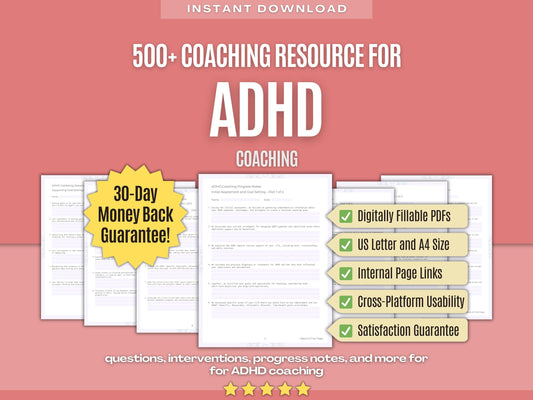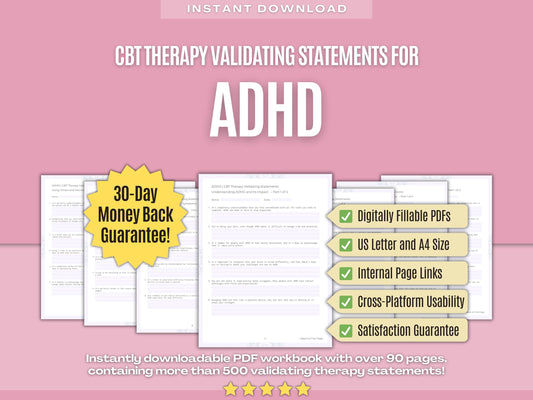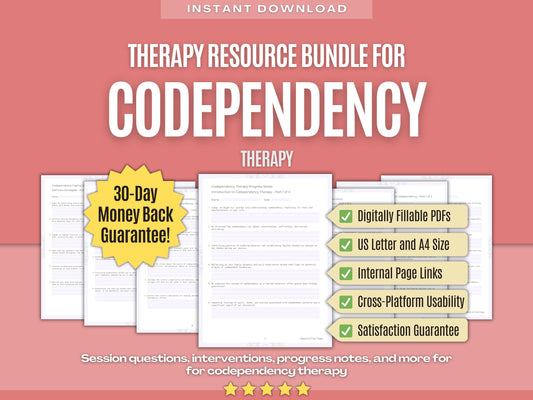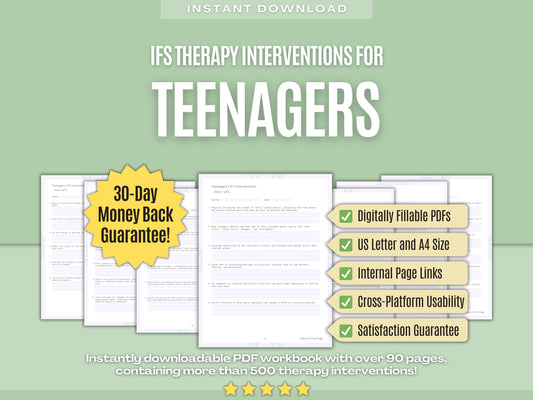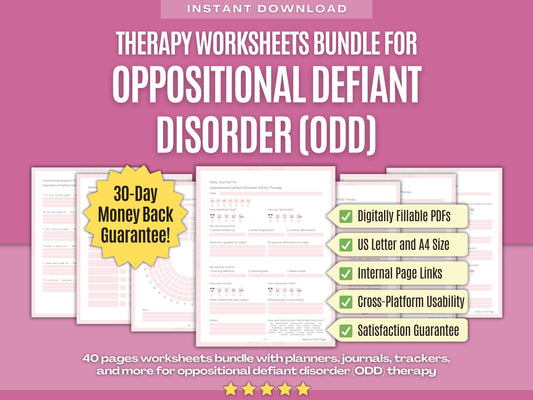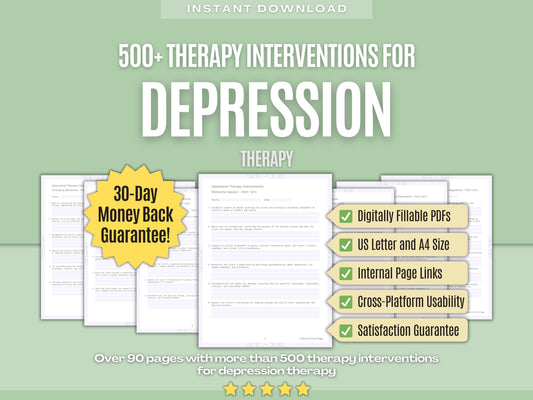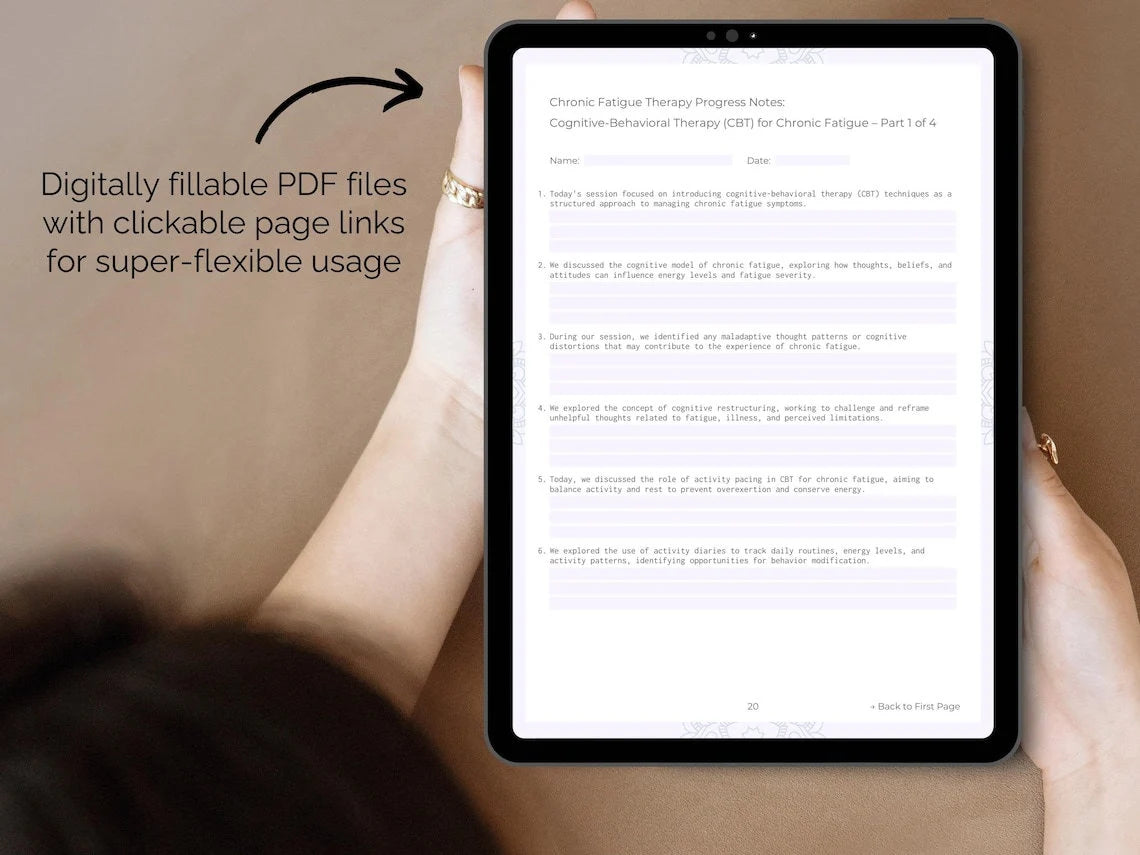Elevate Your Therapy and Guide Your Clients to Inner Healing with Our Self-Compassion Therapy Interventions! ✨
1. Starting Your Self-Compassion Journey
- Begin by introducing the concept of self-compassion, explaining its importance in fostering resilience, emotional well-being, and healthy relationships with oneself and others.
- Explore the common barriers to self-compassion, such as feelings of unworthiness or fear of being perceived as selfish, helping participants identify their own personal obstacles.
- Guide participants through a self-compassion assessment, helping them identify areas of strength and areas for growth in their self-compassion practice.
- Introduce self-compassion exercises and activities, such as writing oneself a letter of self-compassion, practicing loving-kindness meditation, or engaging in acts of self-care.
- Discuss the importance of self-care in nurturing self-compassion, emphasizing the need for balance and boundaries in one's personal and professional life.
- Provide participants with psychoeducation on the neuroscience of self-compassion, explaining how self-compassion practices can rewire the brain and promote emotional resilience.
- Help participants develop a personalized self-compassion plan, setting specific goals and action steps for integrating self-compassion into their daily lives.
- Guide participants through a forgiveness exercise, helping them let go of self-blame and resentment and cultivate compassion toward themselves and others.
- Invite participants to practice self-compassion in everyday situations, such as when facing challenges at work, navigating difficult relationships, or dealing with setbacks and failures.
- Encourage participants to journal about their self-compassion journey, reflecting on their progress, challenges, and insights along the way.
- Teach participants how to respond to self-critical thoughts with self-compassion, acknowledging their pain and suffering with kindness and understanding.
Need more? Find all 500+ Therapy Interventions for Self-Compassion Therapy in our Digital Workbook!
2. Learning About Self-Compassion
- Start by introducing the concept of self-compassion, defining it as the practice of treating oneself with kindness, understanding, and acceptance, especially during times of difficulty or suffering.
- Discuss the three main components of self-compassion: self-kindness, common humanity, and mindfulness, explaining how each component contributes to a compassionate attitude toward oneself.
- Facilitate a discussion on the differences between self-compassion and self-esteem, highlighting how self-compassion focuses on self-acceptance and unconditional positive regard, whereas self-esteem often relies on external validation and comparison with others.
- Explore the role of the inner critic in undermining self-compassion, helping participants recognize when their inner critic is active and how it influences their thoughts, feelings, and behaviors.
- Introduce the concept of self-compassion exercises and activities, such as writing oneself a letter of self-compassion, practicing self-compassion meditation, or engaging in acts of self-care.
- Discuss the benefits of self-compassion for mental health and well-being, such as increased resilience, reduced stress, and improved emotional regulation.
- Invite participants to share their own self-compassion practices and strategies with the group, fostering a sense of community and mutual support.
- Help participants identify their personal values and how they can align their actions with those values in a compassionate way.
- Facilitate a discussion on the barriers to self-compassion, such as feelings of unworthiness, fear of vulnerability, or cultural beliefs about self-care.
- Encourage participants to practice self-compassion in everyday situations, such as when facing challenges at work, navigating difficult relationships, or dealing with setbacks and failures.
- Discuss the connection between self-compassion and forgiveness, exploring how self-compassion can help individuals let go of self-blame and resentment.
Need more? Find all 500+ Therapy Interventions for Self-Compassion Therapy in our Digital Workbook!
3. Mindfulness for Self-Kindness
- Begin by explaining the concept of mindfulness as the practice of being fully present and aware of one's thoughts, feelings, and sensations in the present moment without judgment.
- Teach participants basic mindfulness techniques, such as mindful breathing, body scan meditation, and mindful walking, providing guided instructions and opportunities for practice.
- Explore the role of self-awareness in self-compassion, discussing how mindfulness can help individuals recognize and acknowledge their own suffering with compassion and kindness.
- Facilitate a discussion on the benefits of mindfulness for mental health and well-being, such as reduced stress, increased emotional regulation, and improved self-awareness.
- Help participants identify their personal barriers to mindfulness, such as busy schedules, racing thoughts, or resistance to sitting quietly with their thoughts, and explore strategies for overcoming these barriers.
- Guide participants in developing a personalized mindfulness practice plan, setting specific goals and intentions for integrating mindfulness into their daily lives.
- Invite participants to share their experiences with mindfulness and self-compassion in a supportive group setting, allowing them to learn from one another and build a sense of community.
- Discuss the importance of self-care in maintaining a consistent mindfulness practice, emphasizing the need for balance, boundaries, and self-compassion in one's approach to self-care.
- Explore the connection between mindfulness and resilience, discussing how mindfulness practices can help individuals bounce back from adversity with greater ease and grace.
- Encourage participants to explore different types of mindfulness practices, such as loving-kindness meditation, compassion meditation, or body-based practices, to find what resonates most with them.
- Discuss the ethical dimensions of mindfulness practice, exploring how mindfulness can support greater awareness and compassion in one's actions toward oneself and others.
Need more? Find all 500+ Therapy Interventions for Self-Compassion Therapy in our Digital Workbook!
4. Dialectical Behavior Therapy (DBT) for Emotional Acceptance
- Begin by introducing the principles of Dialectical Behavior Therapy (DBT) and its focus on emotional acceptance, explaining how DBT helps individuals learn to tolerate and regulate intense emotions.
- Discuss the importance of emotional acceptance in self-compassion, highlighting how resisting or suppressing emotions can lead to increased suffering and distress.
- Guide participants in practicing mindfulness exercises focused on increasing awareness of their emotions and physical sensations, helping them cultivate an attitude of acceptance and curiosity toward their inner experiences.
- Provide psychoeducation on the function of emotions and the importance of validating and acknowledging one's own emotional experiences, even when they are difficult or uncomfortable.
- Guide participants in identifying their own emotional triggers and patterns, helping them understand the thoughts, behaviors, and situations that contribute to their emotional distress.
- Discuss the concept of radical acceptance in DBT, explaining how accepting reality as it is, without judgment or resistance, can reduce suffering and promote emotional well-being.
- Explore the role of self-validation in emotional acceptance, discussing how validating one's own emotions and experiences can promote self-compassion and emotional resilience.
- Invite participants to share their experiences with practicing emotional acceptance in a supportive group setting, allowing them to learn from one another and offer validation and encouragement.
- Discuss the importance of self-care in managing intense emotions and promoting emotional acceptance, emphasizing the need for balance, boundaries, and self-compassion in one's approach to self-care.
- Guide participants in developing a self-compassion mantra or affirmation to use during moments of emotional distress, reinforcing their intention to be kind and compassionate toward themselves.
- Encourage participants to engage in activities that bring them joy, fulfillment, and a sense of connection, emphasizing the importance of self-compassion in nurturing one's overall well-being.
Need more? Find all 500+ Therapy Interventions for Self-Compassion Therapy in our Digital Workbook!
5. Interpersonal Therapy (IPT) for Compassionate Relationships
- Begin by introducing the principles of Interpersonal Therapy (IPT) and its focus on improving interpersonal relationships and communication patterns, explaining how IPT can be used to cultivate compassionate and supportive relationships.
- Discuss the four main interpersonal problem areas in IPT—grief, role transitions, interpersonal disputes, and interpersonal deficits—and how these areas can impact one's ability to cultivate compassionate relationships.
- Guide participants in processing unresolved grief or loss through supportive interventions, such as grief counseling, writing letters to lost loved ones, or participating in memorial rituals.
- Teach participants strategies for navigating role transitions with compassion and self-care, such as setting boundaries, seeking support from loved ones, and practicing self-compassion during times of change.
- Guide participants in resolving interpersonal disputes through communication skills training, active listening, and conflict resolution techniques, helping them find common ground and restore harmony in their relationships.
- Explore the connection between interpersonal deficits and self-compassion, discussing how learning to accept and value oneself can lay the foundation for healthier and more compassionate relationships with others.
- Guide participants in practicing assertiveness skills, such as "I" statements, active listening, and negotiation techniques, to help them communicate their needs and preferences in their relationships.
- Teach participants empathy-building exercises, such as perspective-taking, mirroring, and empathic listening, to help them cultivate greater empathy and compassion in their interactions with others.
- Encourage participants to reach out to their social support network for emotional support and encouragement, emphasizing the importance of reciprocity and mutual care in compassionate relationships.
- Teach participants about the concept of attachment styles and how they influence one's patterns of relating to others, discussing how understanding attachment dynamics can enhance interpersonal relationships.
- Explore the connection between self-compassion and compassionate relationships, discussing how cultivating kindness and acceptance toward oneself can enhance one's capacity for empathy and connection with others.
Need more? Find all 500+ Therapy Interventions for Self-Compassion Therapy in our Digital Workbook!
6. Emotion-Focused Therapy (EFT) for Healing Self-Relations
- Begin by introducing the principles of Emotion-Focused Therapy (EFT) and its focus on accessing and processing emotions to promote healing and growth in interpersonal relationships, explaining how EFT can be applied to cultivate self-compassion.
- Discuss the role of emotional awareness and expression in EFT, highlighting how learning to identify and validate one's emotions is a key aspect of cultivating self-compassion.
- Explore the concept of self-soothing in EFT, discussing how individuals can learn to comfort and nurture themselves in moments of distress or discomfort, fostering a sense of safety and security within themselves.
- Discuss the importance of self-validation in EFT, emphasizing the need to acknowledge and accept one's emotions and experiences without judgment or criticism.
- Explore the concept of self-empathy in EFT, discussing how individuals can learn to understand and empathize with their own emotional experiences, offering themselves the same compassion and understanding they would offer to a friend.
- Discuss the impact of early attachment experiences on self-relations, highlighting how experiences of nurturing and support, or lack thereof, can shape one's ability to be compassionate toward oneself.
- Discuss the concept of emotional regulation in EFT, explaining how individuals can learn to manage and cope with intense emotions in healthy and adaptive ways, promoting self-compassion and emotional well-being.
- Explore the connection between self-compassion and self-esteem in EFT, discussing how cultivating self-compassion can lead to greater self-acceptance, self-worth, and resilience.
- Guide participants in processing difficult emotions related to self-criticism, shame, or self-doubt, using EFT techniques such as chair work, two-chair dialogue, or empty-chair exercises to facilitate emotional exploration and expression.
- Teach participants about the importance of self-compassionate boundaries in EFT, emphasizing the need to set limits and protect oneself from self-criticism, perfectionism, and other unhelpful patterns of relating to oneself.
- Discuss the concept of self-forgiveness in EFT, explaining how learning to forgive oneself for past mistakes and shortcomings is a crucial aspect of cultivating self-compassion and emotional healing.
Need more? Find all 500+ Therapy Interventions for Self-Compassion Therapy in our Digital Workbook!
7. Psychodynamic Exploration of Self-Compassion
- Begin by introducing the psychodynamic perspective on self-compassion, explaining how psychodynamic theories focus on unconscious processes, early experiences, and intrapsychic conflicts in shaping one's relationship with oneself.
- Discuss the role of early childhood experiences in psychodynamic approaches to self-compassion, emphasizing how interactions with caregivers and family dynamics can influence one's sense of self-worth, security, and ability to regulate emotions.
- Explore the concept of internalized object relations in psychodynamic theory, discussing how individuals develop internalized representations of significant others as sources of support, validation, or criticism, which can influence their self-relationship.
- Guide participants in exploring their internalized object relations through techniques such as guided imagery, inner dialogue exercises, or drawing representations of their internalized objects.
- Guide participants in exploring their self-representations and how they may impact their self-compassion practice, helping them identify aspects of themselves that are supportive and nurturing, as well as aspects that may be critical or rejecting.
- Guide participants in exploring their unconscious dynamics related to self-compassion through techniques such as dream analysis, free association, or exploring slips of the tongue or memory lapses.
- Guide participants in identifying their own defense mechanisms and how they may impact their ability to cultivate self-compassion, helping them develop awareness and insight into their coping strategies.
- Guide participants in reflecting on their own attachment experiences and how they may have influenced their self-compassion practice, helping them recognize attachment-related patterns in their self-relationship.
- Guide participants in exploring their own unconscious conflicts related to self-compassion, helping them identify competing motivations, fears, or wishes that may influence their self-relationship.
- Teach participants empathy-building techniques, such as mindfulness practices, active imagination, or journaling from different perspectives, to help them cultivate greater empathy and compassion toward themselves.
- Guide participants in practicing self-reflection exercises, such as journaling, reflective writing, or exploring recurring themes in their dreams or fantasies related to self-compassion.
Need more? Find all 500+ Therapy Interventions for Self-Compassion Therapy in our Digital Workbook!
8. Music Therapy for Soothing the Self
- Begin by introducing the concept of music therapy as a tool for soothing the self and cultivating self-compassion, explaining how music can evoke emotions, memories, and sensations that promote relaxation, comfort, and inner peace.
- Explore the use of music listening in therapy for promoting self-soothing and relaxation, explaining how participants can use music as a way to create a safe and nurturing environment for themselves.
- Discuss the use of guided imagery and music (GIM) in music therapy for deepening relaxation and accessing inner resources of strength and resilience.
- Explore the use of songwriting in music therapy for expressing and processing emotions related to self-compassion, explaining how participants can use lyrics and melodies to explore their inner thoughts, feelings, and experiences.
- Discuss the use of improvisation in music therapy for exploring and expressing emotions related to self-compassion, explaining how participants can use musical instruments or their voices to freely express themselves in the moment.
- Explore the use of relaxation techniques such as progressive muscle relaxation, deep breathing, or guided visualization in conjunction with music therapy for enhancing self-soothing and stress reduction.
- Discuss the use of rhythm and drumming in music therapy for promoting relaxation, grounding, and emotional expression.
- Explore the use of group music-making activities in music therapy for fostering a sense of community, support, and shared humanity among participants as they explore themes of self-compassion together.
- Discuss the therapeutic benefits of guided music imagery in music therapy for accessing inner resources of strength, resilience, and self-compassion.
- Explore the use of music-based mindfulness practices in music therapy for promoting present-moment awareness and self-compassionate presence.
- Discuss the use of vocal toning and chanting in music therapy for promoting relaxation, stress reduction, and emotional release.
Need more? Find all 500+ Therapy Interventions for Self-Compassion Therapy in our Digital Workbook!
9. Reflecting on Self-Compassion Development
- Begin by inviting participants to reflect on their journey toward developing self-compassion, acknowledging that it is a process that unfolds over time and may involve both challenges and moments of growth.
- Provide prompts or questions to guide participants in their journaling, such as "What does self-compassion mean to you?" or "How do you typically respond to your own suffering or mistakes?"
- Guide participants in identifying their inner critic or self-judgmental voice, helping them recognize when they are being hard on themselves and exploring the underlying beliefs and fears that drive self-criticism.
- Guide participants in reflecting on moments when they have felt isolated or alone in their suffering, and encourage them to reframe these experiences by recognizing that they are not alone in their struggles and that others share similar challenges.
- Guide participants in practicing mindfulness exercises aimed at cultivating self-compassion, such as mindful breathing, body scan meditation, or loving-kindness meditation directed toward oneself.
- Guide participants in practicing self-kindness exercises, such as writing themselves a compassionate letter, engaging in self-care activities, or giving themselves permission to rest and recharge when needed.
- Guide participants in reflecting on their own journey toward self-acceptance, encouraging them to celebrate their strengths, acknowledge their limitations, and embrace their inherent worthiness.
- Guide participants in exploring their attitudes toward forgiveness, inviting them to reflect on any lingering feelings of guilt, shame, or resentment that may be hindering their ability to extend compassion to themselves.
- Guide participants in identifying their self-care needs and developing a personalized self-care plan, encouraging them to incorporate activities that nourish and replenish them on a regular basis.
- Guide participants in reflecting on their boundaries and exploring areas of their lives where they may need to set firmer limits or assert their needs more effectively to protect their well-being.
- Guide participants in reflecting on times when they have demonstrated resilience in the face of adversity, encouraging them to recognize their strengths, resources, and inner resilience that have helped them persevere.
Need more? Find all 500+ Therapy Interventions for Self-Compassion Therapy in our Digital Workbook!
10. Closing the Chapter on Self-Compassion
- Reflect on specific instances where you've shown self-compassion in the past and acknowledge the progress you've made.
- Create a self-compassion mantra or affirmation that resonates with you and repeat it daily.
- Engage in a self-care activity that nurtures your mind, body, or spirit.
- Cultivate forgiveness towards yourself for past mistakes or shortcomings.
- Explore the concept of common humanity by recognizing that struggles and imperfections are part of the human experience.
- Practice self-compassionate self-talk by speaking to yourself with kindness and encouragement.
- Engage in acts of self-compassion by treating yourself with the same kindness you would offer to a loved one.
- Connect with others who share your journey of self-compassion for mutual support and encouragement.
- Set boundaries to protect your well-being and honor your needs and limitations.
- Engage in activities that bring you joy and fulfillment, celebrating your unique interests and passions.
- Engage in a self-compassion body scan meditation, focusing on sending kindness and acceptance to each part of your body.
We hope that our therapy interventions for Self-Compassion therapy will help you to elevate your therapy practice and guide your clients to inner healing! Do you need more therapy interventions for Self-Compassion therapy? Find them all in our Digital Workbook! Or do you have any questions or suggestions for us? Please feel free to contact us at any time!


